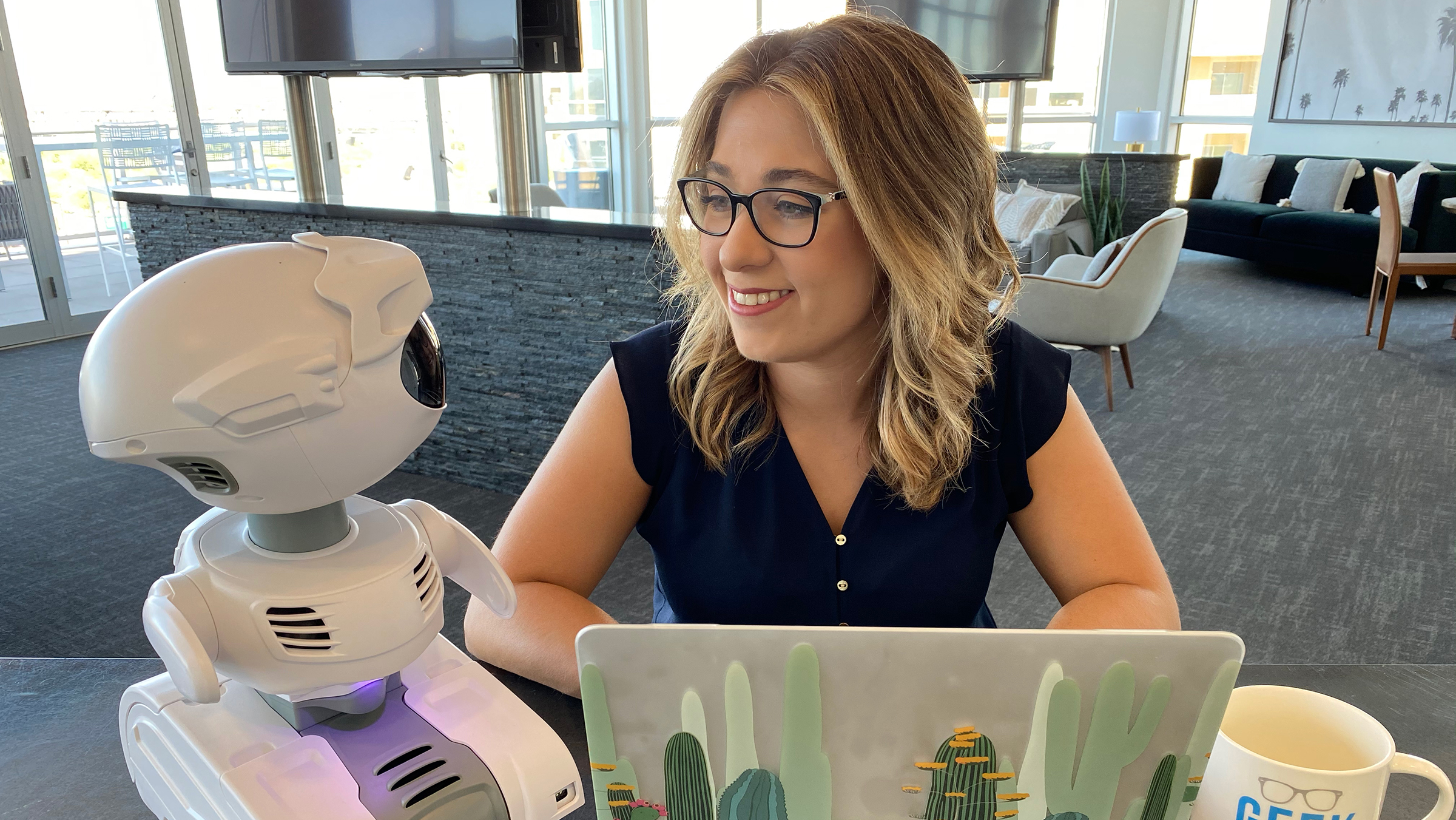
Storytelling robots set to provide dementia relief

Above: Computer science doctoral student Jordan Miller pictured next to Misty, a robot specializing in conversational therapy to assist people coping with Alzheimer's disease. Photo courtesy of Jordan Miller.
As robotics technology advances, robots will help with a variety of tasks, even supporting people to navigate the challenges of aging.
A project led by Troy McDaniel, assistant professor of engineering at The Polytechnic School, one of the six schools in the Ira. A. Fulton Schools of Engineering at ASU, and Lauren Keeler, assistant professor in the ASU School for the Future of Innovation in Society, aims to develop robots to assist older adults with dementia and their caregivers.
The work is supported by the Zimin Foundation as one of four proposals selected for funding within the new Zimin Institute for Smart and Sustainable Cities at ASU. This partnership between the Zimin Foundation and ASU aids research projects that facilitate the integration of smart-city technology, specifically concerning infrastructure, transportation, resource efficiency, health, security and more.
“After seeing the effects of dementia on the person and their caregiver firsthand, I was inspired to develop technology to assist both people,” says computer science doctoral student Jordan Miller, who will lead the project under McDaniel. “The intention is not to replace human interaction, but instead to create an opportunity that allows the caregiver to address their own health.”
According to the Alzheimer’s Association, an estimated 5.8 million Americans live with Alzheimer’s disease, the most common form of dementia, and 83% of informal care is supplied by family, friends or other unpaid caregivers.
In addition to substantial informal care, formal care is estimated to cost $305 billion annually.
By 2050, the number of Americans with Alzheimer’s disease is expected to reach 13.8 million, costing an estimated $1.1 trillion in formal care, placing increasing demand on caregivers who provide informal care for people living with Alzheimer’s disease.
Conversation and narrative have been shown to help people living with cognitive impairment. McDaniel and his team of researchers began exploring storytelling robots as a method of conversational therapy. The Alzheimer’s Association recommends that patients engage in storytelling activities as a way to combat feelings of depression, isolation and aggression.

A series of illustrations developed by Assistant Professor Troy McDaniel’s academic associate, Joshua Chang, demonstrate the uses for a storytelling robot in the role of caregiving for older adults who have dementia. McDaniel is testing different human-robot interfaces to help mitigate negative effects of dementia for both people with the condition and their caregivers. Image courtesy of Troy McDaniel.
C-Care Health Services reports that people living with dementia who engage in storytelling have an improved quality of life. Storytelling can promote a sense of accomplishment, raise self-esteem, improve creative and verbal skills, improve social interaction, provide therapeutic communication opportunities and ease the pressure to remember.
“Our goal is to contribute to the future of in-home caregiving by developing a solution to assist people living with dementia and their caregivers who may not be able to afford an assisted living facility and either live with or require live-in caregiving support,” McDaniel says.
McDaniel’s focus on robotic conversational therapy is a new concept serving as an alternative medium for patient interaction. Along with the conversational aspect, the robot will be programmed to detect the patient’s emotions, allowing them to feel like they are interacting with another person instead of a computer.
Current technology to assist people with Alzheimer’s disease is only patient-focused, but the storytelling robot also takes the caregiver’s well-being into consideration. The presence of a storytelling robot creates an opportunity for the caregiver to manage other tasks or take personal time to improve their own mental and physical health.
“Based on personal experience and caregiver support circles I attended before the COVID-19 pandemic, a person with dementia often tells a story that isn’t true or they continue to repeat a story over and over again, but they are unaware of this due to their condition,” Miller says.
In this scenario, it is recommended that the caregiver allow the person with dementia to tell the story as they would like and as frequently as they’d like, though this can be difficult for the caregiver to observe.
“If the caregiver expresses frustration, it causes confusion and distress with the person living with dementia. The presence of the robot takes this challenge away,” Miller says.
The robot will also include a profile that leads the caregiver through meditation and breathing exercises. In addition, the robot would provide patient safety features like an alert for night wandering, offering peace of mind for the caregiver.
“I also see this technology being deployed in hospital settings to converse with patients who stay overnight,” Miller says. “I envision a future where, in addition to assisting seniors suffering from isolation and depression, this technology can assist entire families battling dementia no matter where they reside.”



































